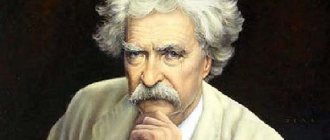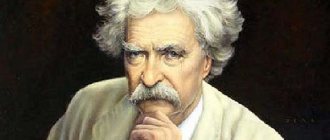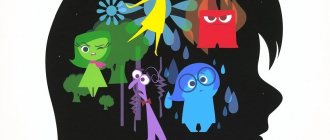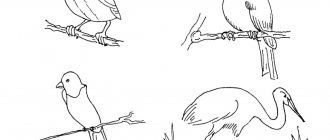Mechanism and types of perception
For the full development and effective learning of a child, a sufficient level of development of perception is necessary. It is the basis for the formation of other cognitive processes (memory, attention, thinking, speech and imagination). How does the process of perception occur?
- The world around us consists of various objects and phenomena that can be seen, heard, touched, tasted, smelled.
- With the help of our senses we learn about what an object is. For example, an orange has the following properties: round, orange, smooth, with small dimples on the peel, sour, and has a specific citrus smell.
- Information from the senses enters the brain, where individual sensations are combined into a holistic “picture” - perception.
- Perception is greatly influenced by accumulated life experience. If a child has already seen and eaten an orange, he does not need to taste it to guess what it is.
Classification of types of perception:
- Visual perception allows you to obtain a visual image of an object, as well as study its details;
- Auditory perception makes it possible to understand speech, recognize various sounds of nature, household noises and hear music;
- Tactile perception - cognition of objects through touch;
- Olfactory perception – recognition of odors;
- Taste perception – receiving information from taste buds (perception of sweet, salty, sour and bitter).
Most experts believe that each of us has a leading channel for receiving “data” about the world (usually vision, hearing or touch). Pay attention to the form in which your baby absorbs information better - this should be the main one in his learning.
Picture perception
The perception of pictures is also of great importance in the development of visual perception in preschoolers. Preschoolers have difficulty perceiving the picture correctly. After all, even in the simplest picture, where there are at least two objects, there is already some kind of spatial connection between them. To reveal the relationship between parts of the image, it is necessary to comprehend these connections, so pictures are traditionally used to determine the general mental development of the baby. At one time, A. Binet used this test in the scale he invented for measuring intelligence. He and his follower V. Stern identified three levels of children's perception of pictures.
- The first stage of enumeration (or subject) is typical for 2-5 year old children.
- Children aged 6-10 years are in the second descriptive or action stage.
- For children over 9-10 years old, the third stage of relationship (or interpretation) begins.
The question itself that an adult asks a child is very important. When the teacher asks what the children see in the picture, he directs them to list all the objects (minor and important) in random order. And the question “What are they doing in this picture?” pushes the baby to reveal functional connections, in other words, actions. When asked to talk about the events depicted, the child tries to understand exactly what is depicted, that is, he rises to the level of interpretation. That is, during the experiment, a child can simultaneously demonstrate all three levels of his perception of the picture. With the development of perception, preschoolers are able to recognize the properties of objects, distinguish between objects, and find out whether there are certain relationships or connections between them. As soon as a reaction to visual information appears, the act of visual perception begins, the qualities of perceived objects are isolated, analyzed and synthesized until awareness and fixation of this information in the form of an image of perception occurs.
Then the visual information turns into a mental image, which is stored in memory and used for learning, orientation and action in the environment. Visual perception is one of the most important types of perception, which has a significant impact on the mental development of the baby, because it is important for both informational and operational significance . It is involved in maintaining balance, orientation in space, regulation of posture and control of behavior.
The formed visual perception is the basis on which the figurative forms of cognition used at school age are based.
Peculiarities of perception in early preschool age (3-4 years)
The perception of 3-4 year old children is characterized by specificity and lack of clarity. The main parameters of perception in early preschool age are color, shape and size. Most often, children pay attention to the most striking of these signs, and the rest of the details are guessed by them. For example, seeing buttons with numbers on the TV remote control, children often decide that it is a telephone. It is interesting that three-year-olds do not recognize even the closest people if they are dressed in carnival costumes. At this age, children clearly distinguish primary colors (red, yellow, blue, green). Little-known shades are perceived as unimportant signs, and therefore are often simply ignored. However, kids learn quickly and remember everything on the fly. The more color standards you introduce your child to, the brighter the baby’s perception will be. Sometimes children evaluate the color characteristics of objects as “beautiful” and “ugly”, so in drawing you can see the child’s color preferences, and not real images of objects.
The properties of objects for younger preschoolers are inseparable from the things themselves, so they are firmly fixed in perception. For example, a baby knows that a cucumber is always green, and can call zucchini, avocado, and green beans cucumbers.
In children of this age, their perception of space is formed through actions with objects. A 3-year-old child is just beginning to distinguish between the concepts of “far” and “close”, so he has difficulty assessing the size of distant objects. For example, looking at the panorama of the city, a child may well think that the houses are toy. To develop the baby’s spatial understanding, you need to pay his attention to his own body (the child will quickly remember that the legs are below, the head is above, and the arms are at the side), and also more often give the child requests indicating the direction (for example, “turn right” , “take the candy from the top shelf” and so on).
How do children of middle preschool age (4-5 years old) perceive the world?
By the age of 5, children achieve significant success in their ability to perceive various parameters of the world around them:
- There are 7 or more colors;
- Have an idea of light and dark tones, “warm” and “cold” shades;
- Know the basic geometric shapes (circle, square, triangle, rectangle);
- Can compare objects by size (large, smaller, small);
- They begin to form the concept of time (today, yesterday, tomorrow, minutes, hours, days, weeks), but they are not yet able to apply knowledge about these abstract concepts into the life of a four-year-old;
- The perception of other people depends on their popularity in society and their relationship with the baby. Mom will always be perceived by the baby as the kindest and most beautiful.
Peculiarities of perception in older preschool age (5-7 years)
In older preschool age, as before, visual sensations dominate perception. Auditory perception begins to actively develop: children are able to identify sounds in words, recognize familiar musical compositions, and feel the tempo and rhythm of a piece. Six-year-old children are well oriented in space (they practically do not confuse “right” and “left”, perceive distances between objects quite accurately, and can navigate plans and diagrams). The perception of time periods (minute, hour, day, and so on) depends on how often parents mention them in communication with their children. If you give your child tasks in which time is one of the guidelines (for example, “draw as many circles as possible in a minute” or “you need to brush your teeth for 2 minutes”), gradually it will no longer be so incomprehensible to the child.
The leading channel of perception for most older preschoolers is vision. At the same time, other types of sensitivity (especially auditory and tactile) are also actively developing.
Games and exercises for developing perception in preschoolers
Play is the leading activity in preschool age. This is why exercises and games are an effective and fun way to develop children's perception.
- Sorting by color, shape, size. Items for sorting can be any available materials: toys, lids, construction parts, cubes, buttons, cereals, pencils, etc. You can organize the game in various ways: placing objects in bowls, “hiding” an object (arranging objects so that they blend into the background), throwing objects into holes of the desired color/shape/size.
- "What is missing". This exercise develops visual perception, thinking and attention to detail. Draw several objects or animals on a piece of paper, but do not finish drawing them. One or more essential features of the objects must be missing (for example, a hare without ears, a table without legs, a car without wheels), and the baby’s task is to say what is missing in the picture.
- "Confusion." Show your child a picture with the contours of familiar objects superimposed on each other. The child must name everyone who is depicted on it.
Regular exercises will help your child develop a high level of various types of perception.
- Puzzles and cut-out pictures. These games, in which the child needs to assemble a whole picture from pieces, are excellent for developing visual perception.
- "Guess by the smell." From available ingredients you can create a whole aroma set (for example, garlic, coffee, cinnamon, berries, cucumber, lemon, chocolate, and so on). Ask your baby to close his eyes and guess the object by smell. You can also invite your child to draw what he associates this or that scent with.
- “Whose sound?” An adult hides behind a screen and uses objects to make various sounds: rustling a bag, tearing paper, knocking with spoons, ringing a bell, pouring water, and so on. The baby must guess which object each sound corresponds to.
- "Magic bag" For this game you will need an opaque bag and small objects of various shapes and textures. Based on his tactile sensations, the baby should pull out the thing that you describe to him.
EARLY CHILDHOOD
(from 1 year to 3 years)
- DEVELOPMENT OF MENTAL FUNCTIONS
Speech . The child’s autonomous speech transforms and disappears quite quickly (usually within six months). Words that are unusual in sound and meaning are replaced with words of “adult” speech. But, of course, a rapid transition to the level of speech development is possible only in favorable conditions - first of all, with full communication between the child and adults. If communication with adults is insufficient or, conversely, relatives fulfill all the child’s wishes, focusing on his autonomous speech, speech development slows down. Delayed speech development is also observed in cases where twins grow up and intensively communicate with each other in a common children's language.
At an early age, passive vocabulary grows quickly. By the age of two, a child understands almost all the words that an adult utters, naming the objects around him. Since a child actively explores the world of things, manipulation with objects is the most significant activity for him, and he can only master new actions with objects together with adults. Later, at 2-3 years of age, understanding of speech-story emerges.
Active speech is also developing intensively: an active vocabulary is growing, the first phrases and first questions appear. By the age of three, the vocabulary reaches 1,500 words. Sentences initially, at about 1.5 years old, consist of 2-3 words. This is most often the subject and his actions, actions and the object of the action, or the action and the place of action. By the age of three, the basic grammatical forms and basic syntactic structures of the native language are mastered. Almost all parts of speech occur in a child’s speech.
A child's speech activity usually increases sharply between 2 and 3 years of age. His circle of contacts is expanding - he can already communicate through speech not only with close people, but also with other adults and children.
Perception . Early childhood is interesting because among all these interrelated functions, perception dominates. Children are maximally connected by the present situation - by what they directly perceive. All their behavior is field, impulsive; nothing that lies outside this visual situation attracts them. At an early age, elementary forms of imagination are observed. A small child is not capable of inventing something or lying. Only towards the end of early childhood does he have the opportunity to say something other than what he really is.
Memory . Although the child can already involuntarily reproduce what he saw and heard before, he remembers something. Since memory becomes, as it were, a continuation and development of perception, it is still impossible to talk about relying on past experience. Early childhood is forgotten just like infancy.
An important characteristic of perception at this age is its affective coloration
.
Observed objects really “attract” the child, causing him to have a strong emotional reaction. The affective nature of perception also leads to sensorimotor unity
.
L.S. Vygotsky: “At an early age, visual, affectively colored perception dominates, which directly turns into action.”
Actions and thinking . Thinking in this age period is usually called visual-effective.
. It is based on the perceptions and actions carried out by the child. And although at about the age of two the child develops an internal plan of action, throughout early childhood objective activity remains an important basis and source of intellectual development.
Thinking initially manifests itself in the very process of practical activity. This is especially clear when a child is faced with a task that adults have not taught him how to solve. Thinking develops in the process of practical activity and from practical activity, therefore, according to domestic psychologists, it lags behind it in terms of the general level of development and the composition of operations.
Not only thinking develops thanks to external activity. The objective actions themselves are also improved. In addition, they acquire a generalized character, being separated from the subjects in which they were originally learned. The mastered actions are transferred to other conditions. Following the separation of actions from the objects with which they were associated and their generalization, the child develops the ability to correlate his actions with the actions of adults, to perceive the actions of an adult as models. The joint activity, in which the actions of an adult and a child were initially merged and intertwined, begins to disintegrate. The adult sets examples of actions for the child, controls and evaluates their implementation.
In addition to actual objective activities, such activities as drawing and playing are also important for the development of a young child. A drawing by a child under 2 years old can hardly be called a drawing; it is more like a scribble. But in the third year, forms that are similar to the depicted object already appear. At 2.5 years old, children can quite clearly draw a person.
The leading activity during this period is object-manipulative. While playing, the child manipulates objects, including toys, focusing on the actions with them. Nevertheless, at the end of early childhood, play with a plot already appears in its original forms. This is the so-called director's game
, in which the objects used by the child are endowed with playful meaning.
For the development of play, the appearance of symbolic or substitutive
actions is important.
2. EMOTIONAL DEVELOPMENT
The development of mental functions is inseparable from the development of the emotional-need sphere of the child. The dominant perception at an early age is affectively colored. The child reacts emotionally only to what he directly perceives.
The child’s desires are unstable and quickly transient, he cannot control and restrain them; They are limited only by punishments and rewards from adults. All desires have equal strength: in early childhood there is no subordination of motives
. This is easy to observe in a choice situation. If a 2-3 year old child is asked to choose one of several new toys, he will spend a long time looking at and sorting through them. Then she will still choose one, but after the next request - to go with her to another room - she will begin to hesitate again.
The development of the emotional-need sphere depends on the nature of the child’s communication with adults and peers. In communication with close adults who help the child explore the world of “adult” objects, the motives of cooperation
, although purely emotional communication, which is necessary at all age stages, is also preserved. In addition to unconditional love and emotional warmth, a child expects direct participation from an adult in all his affairs, a joint solution to any task, be it mastering cutlery or building a tower of cubes. It is around such joint actions that new forms of communication with adults develop for the child.
Communication with other children in early childhood usually only appears and does not yet become full-fledged. In the second year of life, when a peer approaches, the child feels anxious and may interrupt his studies and rush to the protection of his mother. In the third year, he already calmly plays next to other children, but the moments of common play are short-lived, and there can be no talk of any rules of the game. They may show aggressiveness - push or hit another child, especially if he somehow infringed on their interests, say, tried to take possession of an attractive toy. A young child, when communicating with children, always proceeds from his own desires, completely disregarding the desires of others. He is self-centered and not only does not understand the other child, but also does not know how to empathize with him. The emotional mechanism of empathy will appear later, in preschool childhood. Nevertheless, communication with peers is useful and also contributes to the child’s emotional development, although not to the same extent as his communication with adults.
Early childhood is characterized by strong emotional reactions
, related to the immediate desire of the child. At the end of this period, when approaching the 3-year crisis, affective reactions to the difficulties faced by the child are observed. He tries to do something on his own, but nothing works out for him, or there is no adult nearby at the right moment - there is no one to come to the rescue and do it with him.
In addition to “uncontrollable” things, the cause of anger or crying may also be a lack of attention to it from close adults who are busy with business at the very time when the child is trying his best to capture their attention.
self-awareness at this time
.
At about 2 years old, the child begins to recognize himself
in the mirror.
Self-recognition is the simplest primary form of self-awareness. A new stage in the development of self-awareness begins when the child calls himself - first by name, in the third person, then, usually by the age of 3, the pronoun “I” appears. Moreover, the child also develops primary self-esteem
- awareness not only of his “I”, but of the fact that “I am good.” This is a purely emotional formation that does not contain rational components.
The consciousness of “I”, “I am good”, “I myself” and the emergence of personal actions promote the child to a new level of development. The transition period begins - a crisis of 3 years.
3. CRISIS 3 YEARS
The crisis of 3 years - the border between early and preschool age - is one of the most difficult moments in a child’s life. This is destruction, a revision of the old system of social relations, a crisis of identifying one’s “I”, according to D.B. Elkonin. The child, separating from adults, tries to establish new, deeper relationships with them.
Changing the child’s position, increasing his independence and activity, require timely restructuring from close adults. If a new relationship with a child does not develop, his initiative is not encouraged, his independence is constantly limited, and the child experiences actual crisis phenomena that manifest themselves in relationships with adults.
L.S. Vygotsky describes 7 characteristics of the 3-year crisis.
The first is negativism.
.
The child gives a negative reaction not to the action itself, which he refuses to perform, but to the adult’s demand or request. He does not do something because a certain adult suggested it to him. The main motive for action is to do the opposite, i.e. exactly the opposite of what he was told.
The second is stubbornness.
.
This is the reaction of a child who insists on something not because he really wants it, but because he himself told adults about it and demands that his opinion be taken into account. Stubbornness is not the persistence with which a child achieves what he wants.
Third - obstinacy
.
It is directed not against a specific adult, but against the entire system of relationships that developed in early childhood, against the norms of upbringing accepted in the family. The child strives to insist on his desires and is dissatisfied with everything that others offer him and do.
Fourth – protest
—
riot
.
For some children, conflicts with their parents become regular; they seem to be constantly at war with an adult.
Fifth - despotism
.
If the child is the only one in the family, then he can harshly exercise his power over the adults around him.
Sixth – jealousy
.
Seventh – depreciation
.
Old rules of behavior, affection, etc. are devalued.
All these phenomena indicate that the child’s attitude towards other people and towards himself is changing. He is psychologically separated from close adults. This is an important stage in the emancipation of the child; An equally stormy stage awaits him later – in adolescence.
conclusions
At preschool age, children experience a colossal leap in mental development, because during this period all cognitive processes are actively formed. Perception is the basic mental process on the basis of which all others (attention, thinking, speech, memory and imagination) are formed. Over the course of several years, children go from direct sensory perception to the ability to form a generalized idea of objects. If initially a child learns to recognize and evaluate what is in front of him at the moment, based on his own sensations and experience, then in older preschool age the level of development of perception allows him to purposefully study objects or phenomena, highlighting their properties. It is necessary to pay enough attention to the development of perception in children, because the child’s ability to learn largely depends on its level.
Methodology for the development of perception
According to famous psychologist Dale Carnegie, sympathy can be aroused with a simple smile.
Therefore, it is worth paying attention to your smile and learning to smile at passers-by and, in the future, at your interlocutors, in order to start a dialogue, and then create a strong and lasting communication connection
A sincere smile evokes sympathy by default
Today there are many cunning techniques and psychological tricks in dialogue that will allow you to understand your interlocutor and enhance the transmission of your emotions.
You can also gesticulate more and develop facial expressions to make the conversation more lively and make it easier for the interlocutor to convey information.
This will improve the quality of social perception and understand people.
The practice of American psychologist, professor and specialist in the field of psychology of emotions and lie detection Paul Ekman is one of the most effective ways to obtain and develop social perception skills.
It is based on focusing attention in three areas of a person’s face: forehead, chin and nose. Paul Ekman believes that it is the nose, chin and forehead that reflect various emotional states of a person, for example, anger, fear, disgust, sadness.
By analyzing a person’s facial expressions and gestures during a dialogue, you can understand what mood the interlocutor is in and what he is feeling at the moment. The skill of recognizing emotions and gestures allows you to strengthen contact between people. This way you can know what is best to say during the dialogue.









